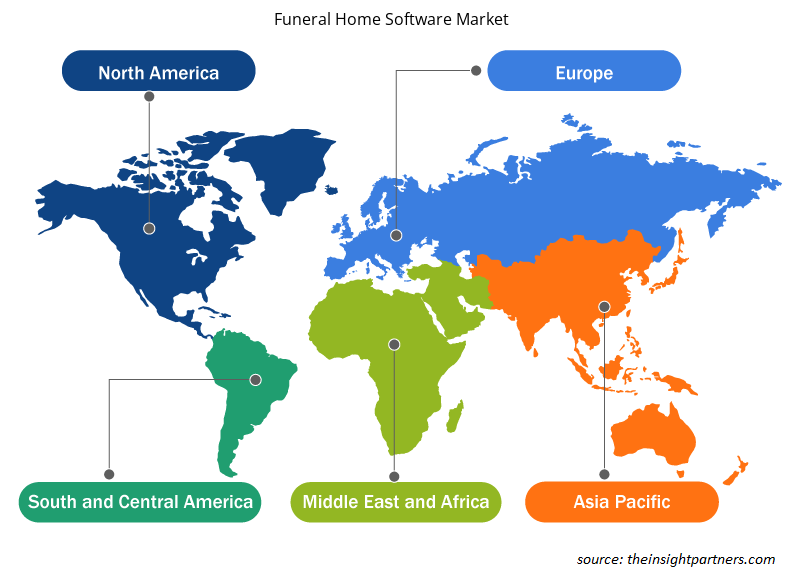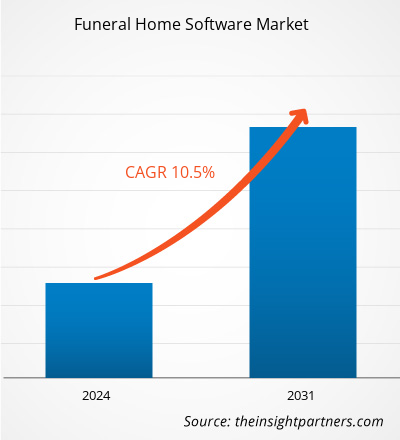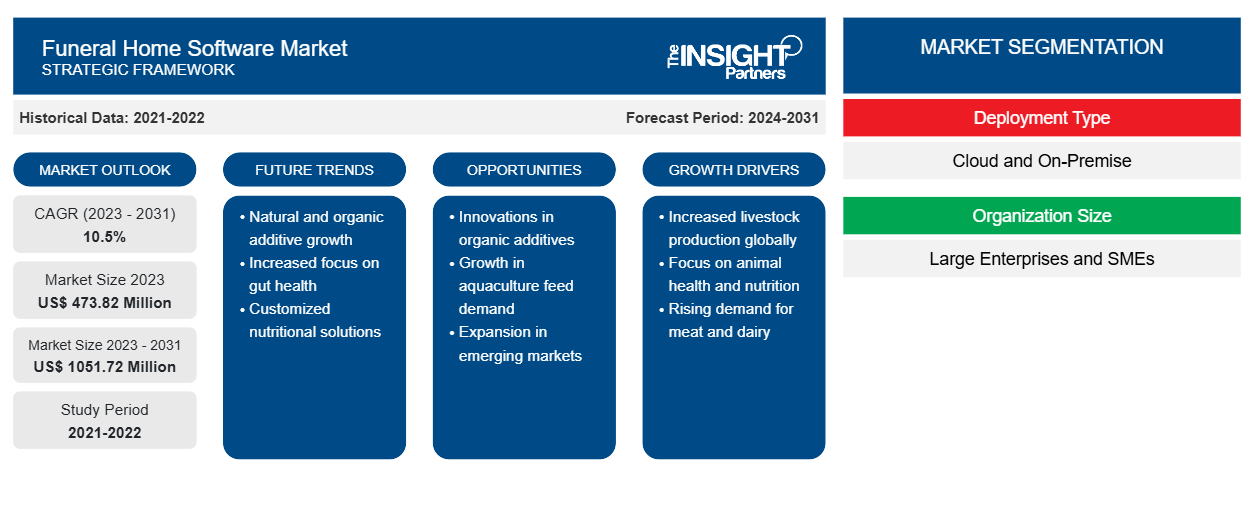Se prevé que el tamaño del mercado de software para funerarias alcance los 1051,72 millones de dólares estadounidenses en 2031, frente a los 473,82 millones de dólares estadounidenses en 2023. Se espera que el mercado registre una CAGR del 10,5 % entre 2023 y 2031. Es probable que el crecimiento de la digitalización y los beneficios que ofrece el software para funerarias sigan siendo tendencias clave en el mercado de software para funerarias.
Análisis del mercado de software para funerarias
El aumento del número de muertes conduce al crecimiento del mercado. La digitalización de las operaciones comerciales en todo el mundo ha ganado fuerza, lo que ha llevado a la adopción de soluciones de software para funerarias. Los beneficios que ofrece el software para funerarias, como la fácil gestión de documentos, la mejora del servicio al cliente, la contabilidad automatizada y otros, fomentan su demanda entre las funerarias de operaciones más rápidas y eficientes. Los operadores y gerentes de funerarias pueden organizar funerales e interactuar con los clientes mediante el software para funerarias. Los operadores de funerarias pueden utilizar soluciones de software para gestionar la programación, los recursos y los servicios personalizados. Con frecuencia, el programa ofrece un portal donde los clientes pueden enviar solicitudes de servicio y compartir información sobre el fallecido.
Descripción general del mercado de software para funerarias
El software para funerarias ayuda a las funerarias, depósitos de cadáveres y crematorios a gestionar y manejar todos los aspectos de las operaciones diarias. Automatiza la contabilidad, el inventario y la gestión de documentos. El software para funerarias proporciona un control total sobre las tareas administrativas. Las funciones de recepción le permiten gestionar los servicios funerarios, compartir y firmar documentación y compartir productos y recuerdos en el sitio web o las redes sociales.
Personalice este informe según sus necesidades
Obtendrá personalización en cualquier informe, sin cargo, incluidas partes de este informe o análisis a nivel de país, paquete de datos de Excel, así como también grandes ofertas y descuentos para empresas emergentes y universidades.
-
Obtenga las principales tendencias clave del mercado de este informe.Esta muestra GRATUITA incluirá análisis de datos, desde tendencias del mercado hasta estimaciones y pronósticos.
Factores impulsores y oportunidades del mercado de software para funerarias
Digitalización para favorecer el mercado
La digitalización está aumentando en todo el mundo. La digitalización está transformando el modelo de negocio, las operaciones y la experiencia del cliente. Por lo tanto, la digitalización en la industria funeraria ayuda a automatizar el proceso funerario. La digitalización de las funerarias aporta eficiencia a toda la gestión de la funeraria. Con la ayuda del software, los clientes pueden firmar digitalmente la documentación necesaria sin tener que estar físicamente presentes. El software para funerarias ayuda a los proveedores de servicios funerarios a organizar la admisión, los horarios de entrega, los horarios de los servicios y las invitaciones. Esto facilita una experiencia positiva para sus clientes durante un momento difícil. Los documentos, como los certificados conmemorativos o los certificados de defunción, se pueden importar y almacenar digitalmente. Estas plataformas ofrecen recursos para archivar datos sobre los arreglos funerarios y los difuntos. Con la ayuda del software para funerarias, el operador de la funeraria puede ayudar a los usuarios a hacer planes para los próximos servicios y crear un registro de los servicios pasados. Muchos tienen los medios para comprar flores, fotografías y otros elementos personalizados para los servicios. Algunos también vienen con herramientas para registrar los registros funerarios. Se pueden crear informes mediante varios programas de software funerario y enviarlos a un software de gestión de bases de datos o de contabilidad.
Aumento de las muertes en todo el mundo: una oportunidad en el mercado del software para funerarias
Con el cambio de estilo de vida y hábitos alimenticios, hay un aumento de enfermedades cardiovasculares (ECV) en todo el mundo. Factores como la contaminación del aire, la presión arterial alta, el consumo de tabaco y el colesterol elevado son algunos de los factores que conducen al aumento del número de muertes. Por ejemplo, según la Federación Mundial del Corazón (WHF), las muertes por ECV aumentaron a nivel mundial de 12,1 millones en 1990 a 20,5 millones en 2021. El Informe Mundial del Corazón se lanzó en la Cumbre Mundial del Corazón de 2023. Por lo tanto, el aumento de muertes por razones específicas llevó a un aumento de las operaciones en la funeraria. La adopción de software para funerarias ayudará a los proveedores de servicios funerarios a gestionar de manera eficiente las operaciones funerarias. Por lo tanto, el aumento de muertes actúa como una oportunidad para el crecimiento del mercado, ya que alentará al proveedor de servicios funerarios a adoptar soluciones para gestionar eficazmente el proceso y la documentación.
Análisis de segmentación del informe de mercado de software para funerarias
Los segmentos clave que contribuyeron a la derivación del análisis del mercado de software para funerarias son el tipo de producto y la aplicación.
- Según los componentes, el mercado se divide en software y servicios. El segmento de software tuvo una mayor participación de mercado en 2023.
- Por implementación, el mercado se segmenta en la nube y en las instalaciones locales. El segmento en las instalaciones locales tuvo la mayor participación del mercado en 2023.
- Por tamaño de empresa, el mercado se segmenta en pymes y grandes empresas. El segmento de grandes empresas tuvo la mayor participación del mercado en 2023.
Análisis de la cuota de mercado del software para funerarias por geografía
El alcance geográfico del informe de mercado de software para funerarias se divide principalmente en cinco regiones: América del Norte, Asia Pacífico, Europa, Medio Oriente y África, y América del Sur/América del Sur y Central.
En términos de ingresos, América del Norte representó la mayor participación en el mercado de software para funerarias. Estados Unidos, Canadá y México se encuentran entre los países clave de América del Norte. La región es una de las primeras en adoptar soluciones tecnológicamente avanzadas, lo que constituye uno de los factores clave que impulsan el crecimiento del mercado. La región alberga a actores del mercado de software para funerarias, entre los que se incluyen Aldor Solutions, FuneralTech, Lytesoft y muchos otros, que impulsan la participación de mercado de la región.
Perspectivas regionales del mercado de software para funerarias
Los analistas de Insight Partners explicaron en detalle las tendencias y los factores regionales que influyen en el mercado de software para funerarias durante el período de pronóstico. Esta sección también analiza los segmentos y la geografía del mercado de software para funerarias en América del Norte, Europa, Asia Pacífico, Oriente Medio y África, y América del Sur y Central.

- Obtenga datos regionales específicos para el mercado de software para funerarias
Alcance del informe de mercado de software para funerarias
| Atributo del informe | Detalles |
|---|---|
| Tamaño del mercado en 2023 | US$ 473,82 millones |
| Tamaño del mercado en 2031 | US$ 1051,72 millones |
| CAGR global (2023 - 2031) | 10,5% |
| Datos históricos | 2021-2022 |
| Período de pronóstico | 2024-2031 |
| Segmentos cubiertos |
Por tipo de implementación
|
| Regiones y países cubiertos |
América del norte
|
| Líderes del mercado y perfiles de empresas clave |
|
Densidad de actores del mercado de software para funerarias: comprensión de su impacto en la dinámica empresarial
El mercado de software para funerarias está creciendo rápidamente, impulsado por la creciente demanda de los usuarios finales debido a factores como la evolución de las preferencias de los consumidores, los avances tecnológicos y una mayor conciencia de los beneficios del producto. A medida que aumenta la demanda, las empresas amplían sus ofertas, innovan para satisfacer las necesidades de los consumidores y aprovechan las tendencias emergentes, lo que impulsa aún más el crecimiento del mercado.
La densidad de actores del mercado se refiere a la distribución de las empresas o firmas que operan dentro de un mercado o industria en particular. Indica cuántos competidores (actores del mercado) están presentes en un espacio de mercado determinado en relación con su tamaño o valor total de mercado.
Las principales empresas que operan en el mercado de software para funerarias son:
- N / A
Descargo de responsabilidad : Las empresas enumeradas anteriormente no están clasificadas en ningún orden particular.

- Obtenga una descripción general de los principales actores clave del mercado de software para funerarias
Noticias y novedades del mercado de software para funerarias
El mercado de software para funerarias se evalúa mediante la recopilación de datos cualitativos y cuantitativos a partir de una investigación primaria y secundaria, que incluye publicaciones corporativas importantes, datos de asociaciones y bases de datos. A continuación, se incluye una lista de novedades en el mercado:
- En marzo de 2022, CTV Software Pty Ltd. anunció Funeral Buddy 6.0 con nuevas funciones. Sus nuevas funciones para sucursales, acceso familiar y otras mejoras mejoran la gestión general de la funeraria. Con la función adicional, la familia obtiene credenciales de inicio de sesión y tiene acceso rápido a los documentos de transferencia. (Fuente: CTV Software Pty Ltd., comunicado de prensa, 2022)
- En marzo de 2023, Strategic Funeral Resources (SFR) presentó cuatro programas de publicidad en redes sociales a precios razonables para ayudar a los proveedores de servicios funerarios a aumentar la participación de los consumidores y aumentar la rentabilidad. Cada programa está disponible en uno de dos paquetes (estándar y preferido) y muchos ofrecen funciones de personalización excepcionales. Los paquetes integran su software de inteligencia artificial patentado Automated Virtual Arranger (AVA). Al digitalizar al propietario de la funeraria o a un miembro del personal, el proceso AVA toma los mejores tipos de interacciones humanas (conexiones atractivas, cálidas y emocionales) y las combina con una tecnología de inteligencia artificial revolucionaria para crear una experiencia de visualización de contenido realista para el público objetivo de una empresa. (Fuente: Asociación Nacional de Directores de Funerarias, comunicado de prensa, 2023)
Informe de mercado de software para funerarias: cobertura y resultados
El informe “Tamaño y pronóstico del mercado de software para funerarias (2021-2031)” proporciona un análisis detallado del mercado que cubre las siguientes áreas:
- Tamaño del mercado y pronóstico a nivel global, regional y nacional para todos los segmentos clave del mercado cubiertos bajo el alcance
- Dinámica del mercado, como impulsores, restricciones y oportunidades clave
- Principales tendencias futuras
- Análisis detallado de las cinco fuerzas de Porter y PEST y FODA
- Análisis del mercado global y regional que cubre las tendencias clave del mercado, los principales actores, las regulaciones y los desarrollos recientes del mercado.
- Análisis del panorama de la industria y de la competencia que abarca la concentración del mercado, el análisis de mapas de calor, los actores destacados y los desarrollos recientes
- Perfiles detallados de empresas
- Análisis histórico (2 años), año base, pronóstico (7 años) con CAGR
- Análisis PEST y FODA
- Tamaño del mercado, valor/volumen: global, regional y nacional
- Industria y panorama competitivo
- Conjunto de datos de Excel
Informes recientes
Informes relacionados
Testimonios
Razón para comprar
- Toma de decisiones informada
- Comprensión de la dinámica del mercado
- Análisis competitivo
- Información sobre clientes
- Pronósticos del mercado
- Mitigación de riesgos
- Planificación estratégica
- Justificación de la inversión
- Identificación de mercados emergentes
- Mejora de las estrategias de marketing
- Impulso de la eficiencia operativa
- Alineación con las tendencias regulatorias























 Obtenga una muestra gratuita para - Mercado de software para funerarias
Obtenga una muestra gratuita para - Mercado de software para funerarias